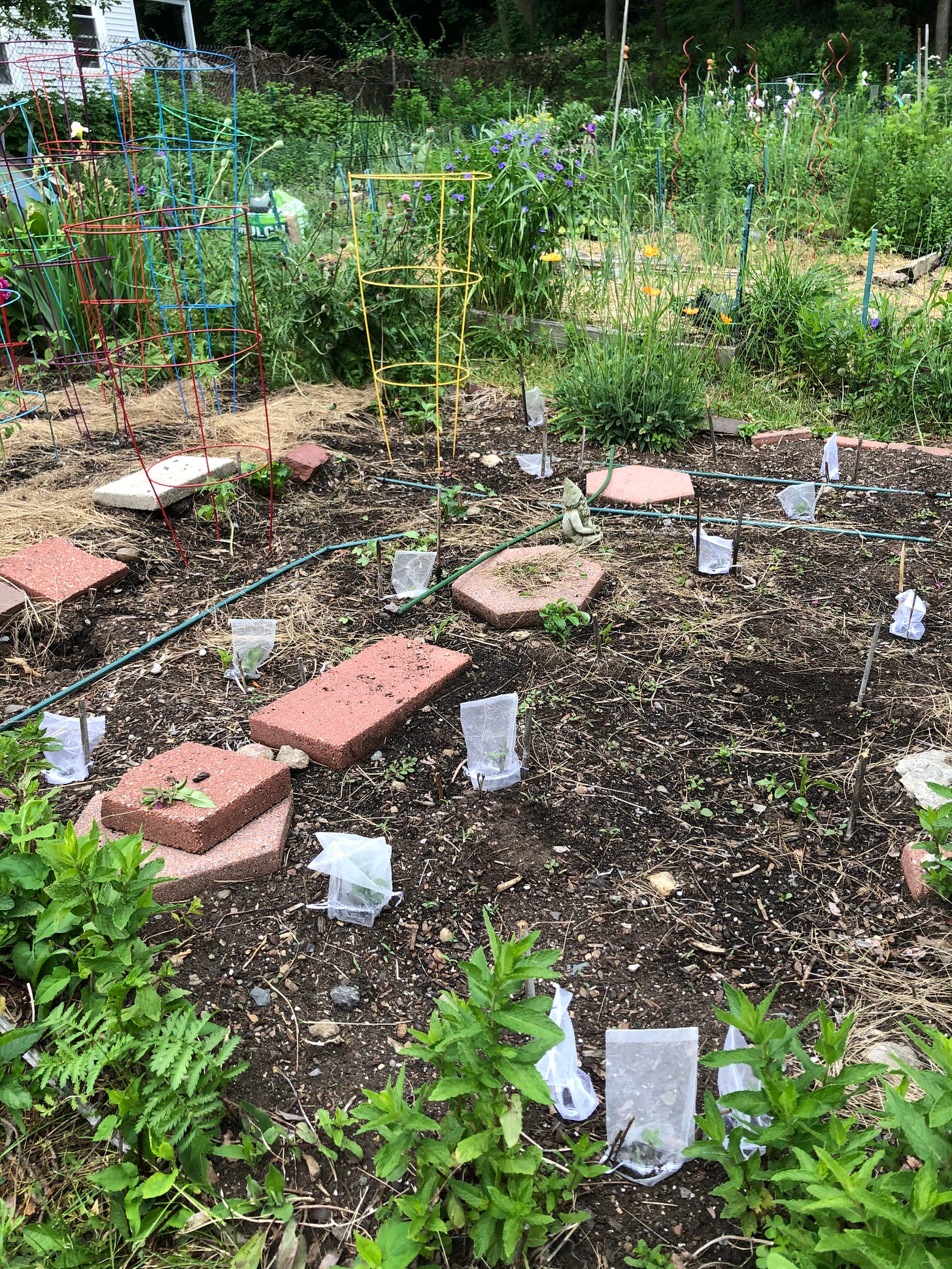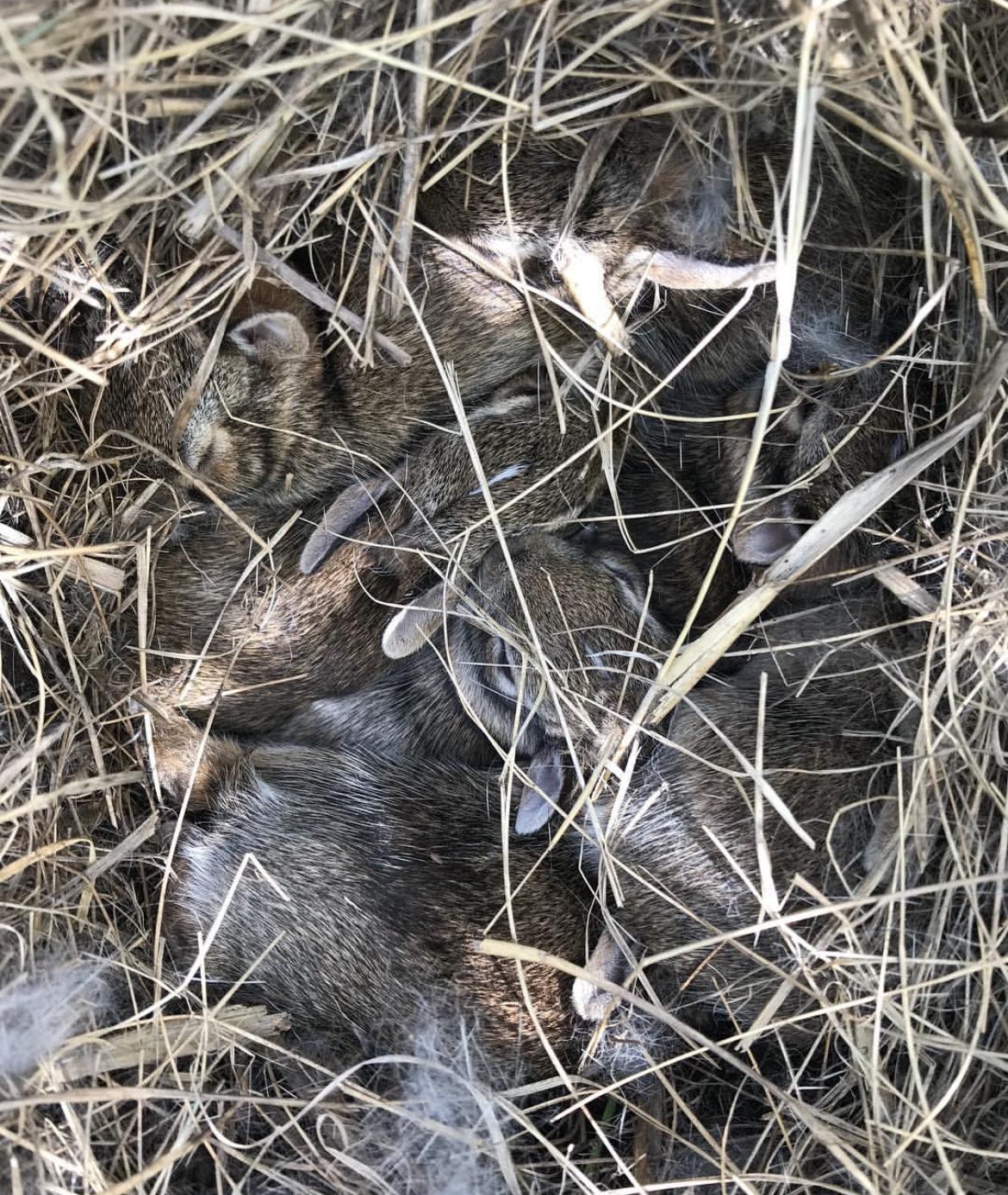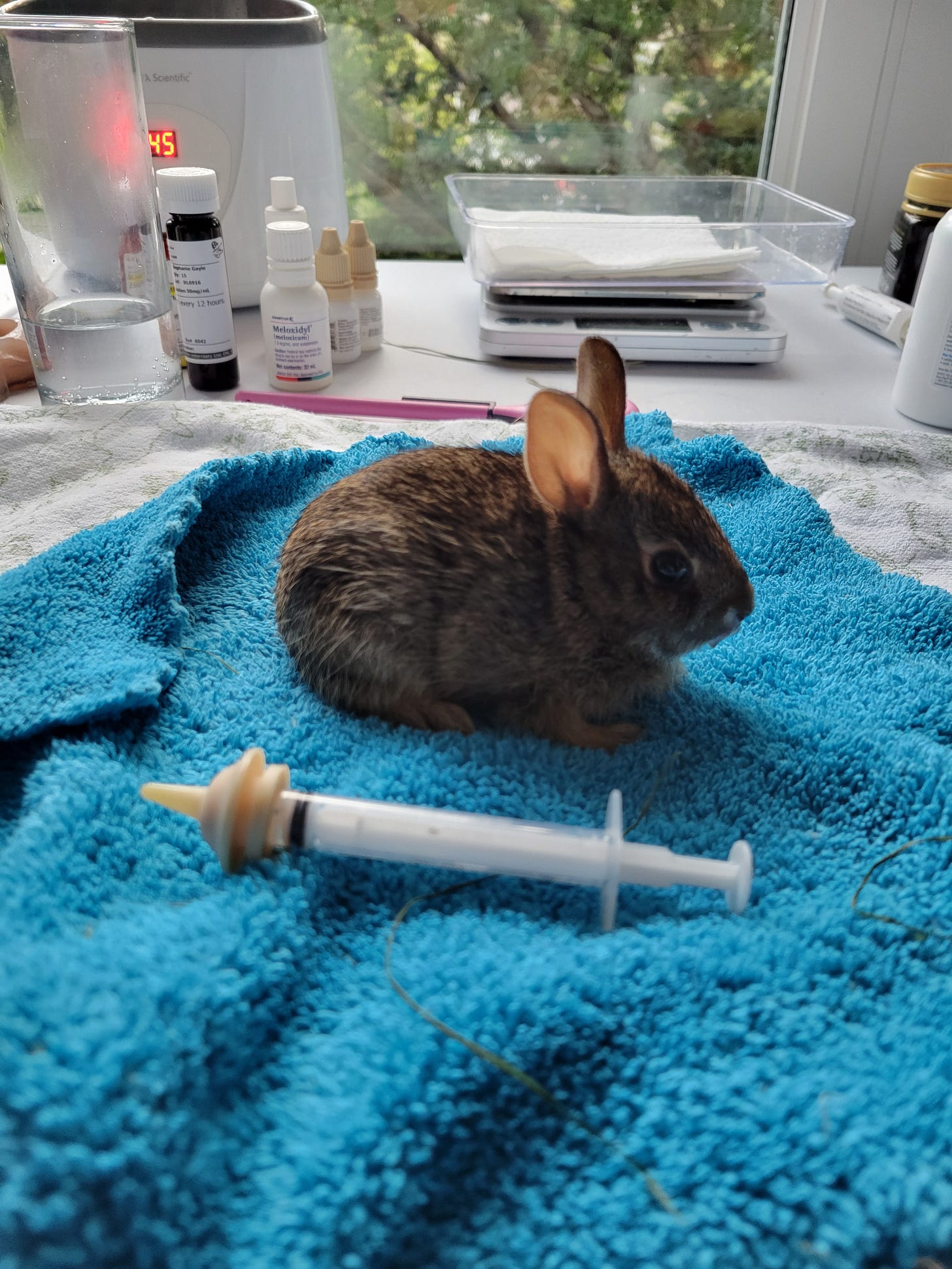
When I first moved to Boston, it was unusual to see a cottontail rabbit. Back then it was a thrilling, unexpected thing to see the flash of a white tail before it vanished under an ornamental bush. Now, thirty-some-odd years later, I see rabbits every single day, regardless of the season. Enjoying the tiny patch of lawn in my front yard. Hopping down the driveway like an off-leash corgi. Sniffing around my neighbors’ yards. Popping out from under a storage shed in the park I walk through daily. Darting through the community garden.
Oh, the community garden.
I’m not proud to admit that when I say the word “rabbit”, the first image that comes to mind is my perfect little flower seedlings–zinnias and cosmos and snapdragons and sunflowers that I had nursed at home and had just put in the ground–clear cut overnight, leaving a plot full of bare green stems, not a leaf in sight. I was not alone. One by one, I watched my friends in neighboring plots erect fences made of wooden posts and chicken wire. Talk around the picnic table was about what to do about them. The problem. The rabbits.
Some had heard that rabbits hated marigolds, and trimmed their plots with bright orange and yellow borders. Others swore that mint was the answer, and added it to their plots, risking one problem (having to battle back mint from taking over your garden for the rest of your life) to solve another. A large kite in the shape of a hawk was hung from a post in the middle of the garden, although there was rarely enough breeze to send it into flight. The rabbits enjoyed the new growth on my dahlia shoots so much that I resorted to covering the leaves with satin-trimmed white mesh party favor bags, making my plot look like the aftermath of a rowdy bridal shower.
One day my neighbor Jen called me over to see what she was growing. She knelt by her bed of tall green garlic shoots surrounded by a thick layer of salt marsh hay she had laid down in the fall. Jen gently moved a layer of hay to reveal a nest of rabbit kits, nestled together in a cozy pile, a tangle of fur and soft ears and little black marble eyes. Six kits in all. We marveled at how small they were, and how comfortable the nest looked, and I wondered aloud about the mom, was she nearby? Jen had done her homework—cottontail moms only visit their nestlings twice a day to nurse. The kits grow quickly, and leave the nest in as soon as three weeks, already able to forage on their own. I spent the next few weeks in the garden happily weeding and planting, listening to my fellow gardeners quietly coo at the young nestlings, peeking in from day to day to watch them grow, until one day they were gone.
Okay, not really gone-gone. Just out of Jen’s garlic patch.
But the inevitable had happened. Pay attention, get to know a creature, even just a little bit, and you can’t help but experience the curiosity and care that leads to love. I stopped seeing the rabbits as a problem and started to see them as valued neighbors whose needs were sometimes in conflict with mine—not unlike a neighbor who throws huge parties every summer weekend, but who, in winter, snowblows your sidewalk down to the cement before you’ve finished your morning coffee. City living teaches us how to coexist with one another, how to negotiate our needs. It reminds us that we are all interdependent, that we all play a part in our shared world.
The eastern cottontail raabbit is an herbivore who eats, in addition to at least some of my seedlings, grasses and clover, fruits and vegetables. By grazing, they help control plant overgrowth and promote plant diversity. They are active all year long and will eat the bark off the bottom of some trees in the winter when food is scarce, which explains the bald rings around the little trees in my next-door neighbor’s well-landscaped yard. They are an important food source to many predators in the city, including hawks, owls, and coyotes, which explains both why their average lifespan is so short (1-2 years) and why their species survival strategy is to breed like, you know, rabbits (3-8 kits in a litter, 3-4 litters per year). Being prey, they have attracted owls and hawks into our garden, which in turn has helped control the rats and voles who also want a piece of the garden action. This raises the question that nature is always asking—and one that I will probably be asking myself for the rest of my life—how do you love both the owl and the rabbit, predator and prey?
The cottontails in my neighborhood are the first creatures to greet me as I leave the house each morning. I love their stillness. I love their fresh tracks in the driveway after a snowfall. I love their white puffy tails. I love how close they let me come to them before they dart away. I less love finding my tulip planters filled with their round poop, but that’s okay. Life is fleeting, sweet cottontail. Have a taste. I can buy tulips at the supermarket.
We are well into the month of April and have entered into baby bird and animal season. The more time I spend paying attention to the natural world, the more creatures I encounter, and the more creatures I encounter, the more I worry about them. I find it comforting to know what to do (and what NOT to do) if I ever encounter an injured bird or animal (because this is the kind of thing I worry about). Massachusetts’ state website has great resources, including a list of certified wildlife rehabilitators and their specialties. Check your state’s fish and wildlife division for guidance and resources where you live. Here are some helpful flowcharts!
My friend Stephanie Gayle is a novelist and a certified wildlife rehabilitator who specializes in caring for injured or abandoned rabbits. I invited her to talk a little about her work.
What was training to become a wildlife rehabilitator like?
I trained to pass the Massachusetts State Wildlife Rehabilitator exam by studying the state’s practice test and New York’s state practice exam, taking online quizzes and enrolling in an excellent four-class course taught at the New England Wildlife Center in Weymouth. In addition, I joined the Wildlife Rehabilitators Association of Massachusetts (WRAM). They have tons of information and resources. Through WRAM, I was paired with a rabbit mentor who helped answer questions and commiserate with me when times got tough. I’ve also taken additional online and in-person courses. There’s so much to learn!
How/why did you choose to specialize in rabbits?
I am very lucky to cohabitate with the world’s most darling domesticated rabbit, Bao, so I knew a bit about rabbits and their challenges. And, unlike birds, which can require feedings every 20 minutes, rabbits are fed only twice a day. Though new guidance shows a mid-day hydration might be optimal for very young rabbits. This feeding schedule works for someone, like me, who has a full-time job. And the space requirements for caging also met with the amount of yard we have. I don’t have the space to accommodate larger species.
How has this work affected your relationship to the natural world?
I pay attention. It boggles my mind how carelessly I used to blunder through the world, blind to the daily wonders of migration and birth, of mating and food gathering. Now, when I see a robin seeking food on the ground, I greet it quietly. “Hello, robin. Good luck!” I am witness to how many animals surround me in my suburban landscape. I closely watch the change of seasons, with an eye to how this affects my wild neighbors. Lots of acorns all over my driveway? Good for squirrels! Terrible drought scorching all the lawns? Bad for rabbits (and other animals)! I think and care about the world in a way I honestly didn’t before. I took it for granted. This spring, I’m planting wild native plants to reduce my lawn and to encourage insects and pollinators which in turn encourages birds. I’m trying to be a good steward of the land. Key word: trying.
What do you wish people knew about wild rabbits?
They are common, even in suburban and urban areas, but they are complex creatures. Their digestive system is closer to that of a horse or cow than to, say, a squirrel’s digestive tract. And they’re prey animals, so their world view is utterly different than ours. We’re apex predators, and we move through the world guided by this knowledge. Not so rabbits.
What does wildness mean to you?
Oh dear. This sent me down a rabbit’s hole (pun intended). We often equate ‘wild’ with freedom (positive) or lawlessness (possibly negative) or operating without constraint. It’s easy to romanticize wildness, to see it as beautiful and unspoiled, and it can be, but as dear old Tennyson wrote, “Nature, red in tooth and claw.” Wildness is brutal too. I think I consider wildness to be that which humans haven’t colonized, but that’s probably reductive and flawed.
Why do you think rabbits have adapted so well to city life?
Because they had to, along with foxes and coyotes and raptors and fisher cats and many other animals. We keep taking their land. It’s adaptation or extinction. There isn’t much middle ground. What rabbits ideally want–grasses and clover and dandelions and low shrubs to hide in and safe spaces to build nests–is in limited supply in cities, but they make do.
Could you talk about what it’s like returning them to the wild?
Nerve wracking. Fun story: when my parents dropped me off at college, my mom got very upset and insisted my dad leave with her immediately, without saying a final farewell. She was overwhelmed. I felt like that the first time I released my rabbit patients into the wild. I’d raised them up from little orphans and I was terrified they’d be snatched up by raptors or simply not thrive in the wild, unfamiliar as they were with it. I watched them leave their carrier and tremble in the new bright world, eventually hopping off to hide under low ground cover. Then I walked through the cemetery where I’d released them, crying. I came across two men who gave me shy smiles as if to say, “We see you. Sorry you’re grieving.” And I thought, “Oh, well, yes, but no. It’s not that.” But I wasn’t going to explain. I got into my car and cried a little more while listening to Nova Amor.
Now, when I release them, I’m more equal parts excited and scared. I will never know how they do, once I let them out into the world. But I am happy they made it to this point, that they have the opportunity to feast on wild greens and feel rain and hear live birdsong and be wild rabbits.
On my walk this evening, I was thinking about the good work that wildlife rehabilitators do, volunteering their time to care for these wild creatures, to give them a chance to live, as Mary Oliver said, their one wild and precious life. I am inspired by their dedication to protect the vulnerable. That seems like a very good thing for all of us to do, whenever we can, in every corner of our lives.
I’ll leave you with my Metta meditation phrases, the wishes I extend to all my animal and bird and plant friends, the wishes I have for all of you. May all beings be safe and protected. May all beings be healthy and strong. May all beings know happiness and peace. May all beings be free.
Your friend,
Louise
P.S. What creatures have you encountered as spring is unfolding? I just saw my first hermit thrush! I would love to hear what you are seeing and hearing in the comments!









My husband and I go only nightly bunny walks in thr spring and summer-- we walk around our neighborhood and count the bunnies we see. We usually get into the 20s and sometimes 30s, with many a baby bunny in sight, and it makes us very happy and excited. We love having bunnies in our yard, too. We found a baby one just the other day. However, I hate them eating my tulips, which they have faithfully done every year but this one. This year, I brewed my own batch of natural rabbit repellent: water, lots of jalapeños and habanero peppers, cinnamon, cloves, garlic powder, and vegetable oil. I've spritzed my tulips EVERY DAY with this mixture, from the moment they started shooting up through the earth, and so far, so good: the tulip buds should open this week. I'm happy to have found a safe way to coexist with our bunny friends (and deer, since i'm pretty sure they eat the tulips, too).
It is such a delight when we drive to Boston and see the rabbits!!! They seem to be EVERYWHERE in the city, wherever we're walking - Ooh there's ONE! - and we always stop and coo and watch. The best part is they're so immune to humans that we can stand there gawping and they couldn't care less, so we can be weird bunny oglers without issue. LOL
Loved reading about your friend's wildlife rehabilitation experience. So inspiring! I had to nurse our injured rabbit, Prudence, back to health years ago - syringe feeding her like a baby for days and days. She recovered eventually, such a joy. But they don't live long enough sadly, even as pets. We lost our other bunny to raccoons back in West Philly. They got into the backyard hutch.